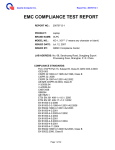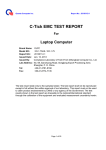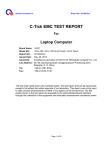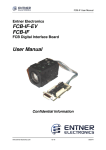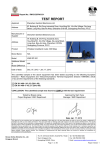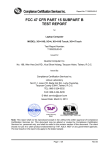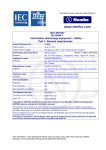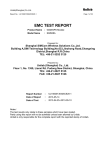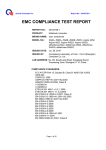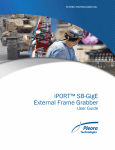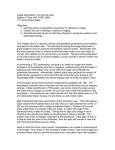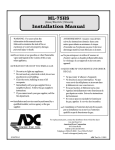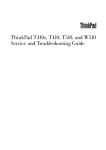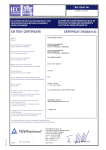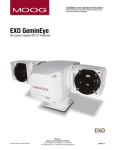Download CL2 CE EMC Report 20111123
Transcript
Quanta Computer Inc. Report No.: 20111123-1 CE EMC TEST REPORT For Laptop Computer Brand Name: OLPC Model NO.: XO-1.75, XO-1.75HS Report NO.: 20111123-1 Issued Date: Nov. 23, 2011 Issued By: Compliance Laboratory of Tech-Front (Shanghai) Computer Co., Ltd Lab Address: No. 68, Sanzhuang Road, Songjiang Export Processing Zone, Shanghai, P. R. China Tel: +86-21-3781-8168 Fax: +86-21-6774-7135 The test result relate only to the samples tested. The test report shall not be reproduced except in full without the written approval of our laboratory. This report must not be used to claim product endorsement by CNAS or any agency of the Government. The test results shown in the test report are traceable to the national/international standard through the calibration of the equipment and evaluated measurement uncertainty herein. Page 1 of 60 Quanta Computer Inc. Report No.: 20111123-1 Test Report Certification Applicant: Manufacturer: Product: Brand Name: Model Number: Tested Voltage: Tested Date: Applicable Standards: Emission: Immunity: Quanta Computer Inc Quanta Computer Inc Laptop Computer OLPC XO-1.75, XO-1.75HS 230VAC, 50Hz Nov. 15-Nov. 19, 2011 EN 55022: 2006+A1: 2007, Class B EN 61000-3-2: 2006+A1: 2009+A2: 2009 EN 61000-3-3: 2008 EN 55024:1998+A1:2001+A2:2003 EN 61000-4-2:1995+A1:1998+A2:2001 EN 61000-4-3:2006 EN 61000-4-4:2004 EN 61000-4-5:2006 EN 61000-4-6:2007 EN 61000-4-8:1993+A1:2001 EN 61000-4-11:2004 Test Result No non-compliance noted The above equipment has been tested by Compliance Laboratory of Tech-Front (Shanghai) Computer Co., Ltd., and found compliance with the requirements set forth in the Electromagnetic Compatibility Directive 2004/108/EC and technical standards mentioned above. The result of testing in this report apply only to the product/system, which was tested. Other similar equipment will not necessarily produce the same resluts due to production tolerance and measurement uncertainties. Approved By Reviewed By Herculus Hsu/ EMC manager: Bill Bo/ Senior engineer Page 2 of 60 Quanta Computer Inc. Report No.: 20111123-1 Section 1: General Information…………………………….……....……… 6 1.1 Test result summary …………………...………………………….………6 1.2 Introduction …………………………………………………………...…………7 1.3 Test Procedure ……………………………………….………………………..8 Section 2: Test Facility and Procedure………………………………..….9 2.1 Test Facility used for Emission Testing ………………………..……. .9 2.1.1 Measurement Uncertainty …………………………………………..……. .9 2.1.2 Lab Accreditation ……………………………..…………..…….……..….…10 2.1.3 Software to exercise EUT ……………………………………………….…10 2.1.4 Special Accessories …………………….……………………………….….10 2.1.5 Equipment Modifications and Deviations ………………………………...10 2.1.6 Test Configuration …………………………..……………………..……….11 - Arrangement block diagram ……………………………………..……..…. 11 - Associated equipment ……………..……………………………..………... 11 - Pre-test configuration ……………..………………………………..……….13 - Worst case for final testing ………………………………………..………. 13 2.1.7 Cable Description and Information ………………………….……………13 2.2 Measurement Equipment ……………….………………………..……. 14 2.2.1 Conducted Emissions ……………………………………………………..14 2.2.2 Radiated Emissions …………..……………………………………………14 2.2.3 Power Harmonic / Flickers …………………………………………………15 2.2.4 Electrostatic Discharge (ESD) Immunity …………...…………..…….…..15 2.2.5 Radiated Electromagnetic Field Immunity ………….…………..…….….15 2.2.6 Fast Transient / Burst Immunity ……………………..……………………16 2.2.7 Surge Immunity …………………………..………………………..…….….16 2.2.8 Conducted Disturbance / Induced Radio-Frequency Field Immunity ...16 2.2.9 Power Frequency Magnetic Field Immunity ………………………….….17 2.2.10 Voltage Dips / Short Interruptions and Interruptions ……….………….17 Page 3 of 60 Quanta Computer Inc. Report No.: 20111123-1 Section 3: Electromagnetic Emissions Test……………………………. 18 3.1 Emission ……….………………………………………………………………. 18 3.1.1 Line Conducted Emissions Test ………………………………………..…. 18 - Measurement Procedures Utilized for Conducted Emissions ……..………. 18 - Limits ……………………………………….………...………………….………. 19 - Test setup………….…………………………………………………….………. 20 - Conducted Emissions Test Data …………………………………….…..……. 21 3.1.2 Radiated Emissions Test ………………………………………………...… 23 - Measurement Procedures Utilized for Radiated Emissions …………..……. 23 - Limits ……………………………………….……………………………………. 24 - Test setup………….…………………………………………………….………. 24 - Radiated Emissions Test Data ……………………………………….………. 26 3.1.3 Power Harmonics Measurement ……………………………………….… 30 - Measurement Procedures Utilized for Harmonics…………………….……. 30 - Test setup……………………….…………………………………….………. 31 - Test Condition…………….……………………………………………….……. 31 - Test results…………………………………………………………….………. 31 3.1.4 Power Voltage Fluctuation / Flicker Measurement ………………………32 - Measurement Procedures Utilized for Flicker……….…………….………. 32 - Test setup…………………..………………………………………….………. 32 - Test Condition………………………………………………………….………. 33 - Test results…………………………………………………………….………. 33 3.2 Electromagnetic Immunity Report ……………………….......…………34 3.2.1 Electrostatic Discharge (ESD) Immunity Test …………….………………35 - Measurement Procedures Utilized for ESD………………………….………. 35 - Test setup……………………………………………………………….………. 36 - Test Condition………………………………………………………….………. 37 - Test results………………………………………………………………….…… 38 3.2.2 Radiated Electromagnetic Field Immunity Test ………….…….…………39 - Measurement Procedures Utilized for RS.……..…….……………….……. 39 - Test setup……………………………………………………………….………. 39 - Test Condition………………………………………………………….………. 40 - Test results…………………………………………………………….………. 40 3.2.3 Fast Transient/Burst Immunity Test……………………...…………………41 - Measurement Procedures Utilized for EFT………………………….………. 41 - Test setup………………………………………………………………………. 41 - Test Condition………………………………………………………….………. 42 - Test results…………………………………………………………….………. 42 Page 4 of 60 Quanta Computer Inc. Report No.: 20111123-1 3.2.4 Surge Immunity Test ………...…………………………………………… 43 - Measurement Procedures Utilized for Surge……………………….………. 43 - Test setup……………………………………………………………….………. 43 - Test Condition………………………………………………………….………. 44 - Test results…………………………………………………………….………. 44 3.2.5 Conducted Disturbance / Induced Radio-Frequency Field Immunity Test - Measurement Procedures Utilized for CS.………………………….………. 45 - Test setup……………………………………………………………….………. 45 - Test Condition………………………………………………………….………. 46 - Test results…………………………………………………………….………. 46 3.2.6 Power Frequency Magnetic Field Immunity Test ……………...........… 47 - Measurement Procedures Utilized for PFMF.……………………..……….… 47 - Test setup……………………………………………………………….………. 47 - Test Condition…………………………………………………………...………. 48 - Test results…………………………………………………………….…...……. 48 3.2.7 Voltage Dips / Short Interruptions and Interruptions Test ………….…… 49 - Measurement Procedures Utilized for Dips………………………….………. 49 - Test setup……………………………………………………………….………. 49 - Test Condition………………………………………………………….………. 50 - Test results…………………………………………………………….………. 50 Section 4: Test Arrangement Photos………………………..………………51 4.1 Conducted Emissions …………………...……………………………………51 4.2 Radiated Emissions ……………………..…………………….……………52 4.3 Power Harmonics and Flick Measurement ………...…………………….. 54 4.4 Electrostatic Discharge (ESD)…………………….……...……..………... 55 4.5 Radiated Electromagnetic Field Immunity………………..…………….... 58 4.6 Fast Transient / Burst Immunity……………………….….………..………58 4.7 Surge Immunity………………………………………………….……….…. 59 4.8 Conducted Disturbance, Induced Radio-Frequency Field Immunity…..…59 4.9 Power Frequency Magnetic Field Immunity Test ……………………...…. 60 4.10 Voltage Dips / Short Interruptions and Interruptions……………………. 60 Page 5 of 60 Quanta Computer Inc. Report No.: 20111123-1 Section 1: General Information 1.1 Test Result summary Emission Standard Item Result Remarks Conducted (Main Port) PASS Meet Class B limit Conducted (Telecom port) PASS Meet Class B limit Radiated PASS Meet Class B limit EN 61000-3-2: 2006 Harmonic current emissions PASS NA EN 61000-3-3 (1995) + A1 (2001) + A2 (2005) Voltage fluctuations & flicker PASS Meets the requirements EN 55022: 2006+A1: 2007 Immunity【EN 55024:1998 + A1: 2001 + A2: 2003 】 Standard Item Result Remarks EN 61000-4-2: 2009 ESD PASS Meets the requirements of Performance Criterion B EN 61000-4-3: 2006 RS PASS Meets the requirements of Performance Criterion A EN 61000-4-4: 2004 EFT PASS Meets the requirements of Performance Criterion B EN 61000-4-5: 2006 Surge PASS Meets the requirements of Performance Criterion B EN 61000-4-6: 2007 CS PASS Meets the requirements of Performance Criterion A EN 61000-4-8:2001 PFMF PASS Meets the requirements of Performance Criterion A PASS Meets the requirements of Voltage Dips: 1) >95% reduction Performance Criterion B 2) 30% reduction Performance Criterion C Voltage Interruptions: 1) >95% reduction Performance Criterion C. EN 61000-4-11: 2004 Voltage dips & voltage variations Note: 1) The test result judgment is decided by the limit of test standard 2) The information of measurement uncertainty is available upon the customer’s request. Page 6 of 60 Quanta Computer Inc. Report No.: 20111123-1 1.2 Introduction Product Laptop Computer Trade Name OLPC Model Name XO-1.75, XO-1.75HS Housing Type Plastic Bestec AC Power Adapter Darfon Model NA0241WAA Model BT-AG250SDF Model BU24-1203 Model BB0J-C AC Power Adapter I/P: 100-240Vac Rating O/P: 13.5Vdc, 1.85A/12Vdc, 2A AC Power Cord Type Non-shielded AC 2pin (0.9m) DC Power Cable Type Non-shielded DC (1.5m) /Non-shielded DC (1.8m) CPU Marvell Memory Capacity 512MHz/1GB 7.5’’LCD Panel CHIMEI eMMC 4GB / 8GB Camera WLAN Battery Model ARMADA 610 Model LS075AT011 SUYIN Model CM0316-OLPC01 QMI Model EM113-MV Liteon Model WN6301MH BYD Model CL1 Page 7 of 60 Quanta Computer Inc. Report No.: 20111123-1 I/O Port: I/O Port Types Quantity Audio in port 1 Audio out port 1 USB port 3 SD Card port 1 1.3 Test Procedure The EUT was tested using special test software called H patterns, which exercises all external I/O ports as well as the internal storage media by writing and reading (if applicable) a continuous stream of “H” characters in font 9. A pattern of continuous stream-scrolling black “H” on a white background was written to display. Played through the internal audio while the EMC testing was being done. The measurements were made while the system was exercised in this manner. Page 8 of 60 Quanta Computer Inc. Report No.: 20111123-1 Section 2: Test Facility and Procedure 2.1 Test Facility Used for Emission Testing Conducted Emissions Facilities: Conducted Emissions were performed at Compliance Laboratory of Tech - Front (Shanghai) Computer Co, Ltd of No.68 Sanzhuang Road, Songjiang Export Processing Zone, Shanghai, P. R. China FCC Registration No. 602285 VCCI Registration No. C-2529/ T-1836 Radiated Emissions Facilities: Radiated Emissions measurements were performed at Compliance Laboratory of Tech-Front (Shanghai) Computer Co., Ltd. of No.68 Sanzhuang Road, Songjiang Export Processing Zone, Shanghai, P. R. China FCC Registration No. 602285 VCCI Registration No. R-2319 (10m Chamber)/ G-191 (10m Chamber) / R-3341 (3m-2Chamber) / G-209 (3m-2 Chamber) /R-2320 (3m Chamber site 1) Note: “R-”to represent bellows 1GHz, “G-”to represent above 1GHz. 2.1.1 Measurement Uncertainty The measurement uncertainty has been determined to be the following: AC Conducted Emissions = 2.4 dB Telecom Conducted Emissions = 2.8 dB Radiated Emissions (30MHz~1000MHz) = 3.9 dB Radiated Emissions (1000MHz~18000MHz) = 4.8 dB The equipment conforms to the requirement of CISPR 16-1, CISPR 16-4-2, ANSI C63.2 and other required standards. Calibration of all test and measurement, including any accessories that may effect such calibration, is checked frequently to ensure the accuracy. Adjustments are made and correction factors are applied in accordance with the instructions contained in the respective manual. Page 9 of 60 Quanta Computer Inc. Report No.: 20111123-1 2.1.2 Lab Accreditations Coverage USA Japan ISO/IEC 17025 Agency Scope of Accreditation Logo FCC 3/10 meter chamber and conducted test chamber to perform FCC Part 15/18 measurements 602285 VCCI CNAS 3/10 meter chamber and conducted test chamber to perform radiated / conducted measurements R-2320 / R-2319/ G-191 C-2529/ T-1836 FCC 47CFR Part 15; CISPR22; AS/NZS CISPR 22; V-3/2008.04; GB9254; GB17625.1; EN55022; EN61000-3-2; EN 61000-3-3; CISPR24; EN55024; IEC/EN61000-4-2; IEC/EN61000-4-3; IEC/EN61000-4-4; IEC/EN61000-4-5; IEC/EN61000-4-6; IEC/EN61000-4-8; IEC/EN61000-4-11 2.1.3 Software to Exercise EUT The EUT was tested using special test software called H patterns, which exercises all external I/O ports as well as the internal storage media by writing and reading (if applicable) a continuous stream of “H” characters in font 9. A pattern of continuous stream-scrolling black “H” on a white background was written to display. Played through the internal audio while the EMC testing was being done. The measurements were made while the system was exercised in this manner. 2.1.4 Special Accessories There were no special accessories used during these tests. 2.1.5 Equipment Modifications and Deviations There is no EUT modification or test standard deviation. Page 10 of 60 Quanta Computer Inc. Report No.: 20111123-1 2.1.6 Test Configuration The EUT was configured as a worst case system configuration as a result from pre-testing as described below: Arrangement Block Diagram Adapter Headphone & Microphone 1 EUT USB Disk 2 USB Keyboard 3 USB Mouse 4 Associated Equipments No. 1 Interference Equipment Audio in & out port Mic & Headphone Brand Model Philips SHM3300 2 USB port Ipod Apple A1285 3 USB port Keyboard Logitech Y-BP62a 4 USB port Mouse Logitech M-BP82 Page 11 of 60 Quanta Computer Inc. Report No.: 20111123-1 Pre-test configuration Prior to taking the formal emissions data collected in this report many hours of pre-testing have been performed. The selection of the worst case system documented in this report was based upon this pre-testing. Mode CPU LCD Panel 1 Marvell ARMADA 610 CHIMEI LS075AT011 512M 4GB 2 Marvell ARMADA 610 CHIMEI LS075AT011 1GB 8GB Liteon WN6301MH 3 Marvell ARMADA 610 CHIMEI LS075AT011 512M 4GB QMI EM113-MV Marvell ARMADA 610 Marvell ARMADA 610 Marvell ARMADA 610 CHIMEI LS075AT011 CHIMEI LS075AT011 CHIMEI LS075AT011 1GB 8GB Liteon WN6301MH 512M 4GB 1GB 8GB Marvell ARMADA 610 Marvell ARMADA 610 Marvell ARMADA 610 Marvell ARMADA 610 CHIMEI LS075AT011 CHIMEI LS075AT011 CHIMEI LS075AT011 CHIMEI LS075AT011 1GB 8GB 512M 4GB 1GB 8GB 512M 4GB 4 5 6 7 8 9 10 Memory eMMC WLAN Camera Battery Adapter BYD CL1 Bestec NA0241WAA AZUREWAVE AM-1H018 BYD CL1 Bastec BT-AG250SDF AZUREWAVE AM-1H018 BYD CL1 Darfon BU24-1203 BYD CL1 Darfon BB0J-C AZUREWAVE QMI EM113-MV AM-1H018 AZUREWAVE AM-1H018 AZUREWAVE QMI EM113-MV AM-1H018 Liteon AZUREWAVE WN6301MH AM-1H018 AZUREWAVE AM-1H018 Liteon AZUREWAVE WN6301MH AM-1H018 AZUREWAVE QMI EM113-MV AM-1H018 Liteon AZUREWAVE WN6301MH AM-1H018 QMI EM113-MV Page 12 of 60 BYD CL1 BYD CL1 BYD CL1 BYD CL1 BYD CL1 BYD CL1 Bastec BT-AG250SDF Darfon BU24-1203 Darfon BB0J-C Bastec NA0241WAA Bastec NA0241WAA Darfon BB0J-C Quanta Computer Inc. Report No.: 20111123-1 Worst Case for Final Testing (Mode 4 chosen) Component Vendor Part Number CPU Marvell ARMADA 610 LCD Panel CHIMEI LS075AT011 Memory Hynix 1GB eMMC Toshiba 8GB WLAN Liteon WN6301MH Camera AZUREWAVE AM-1H018 Battery BYD CL1 Power Adapter Darfon BB0J-C 2.1.7 Cable Description and Information Cable Type Shielded Ferrite Length USB Keyboard No No 1.5m USB Mouse No No 1.8m USB 2.0 Ipod Yes No 1.0m Audio In No No 1.8m Audio Out No No 1.8m Page 13 of 60 Quanta Computer Inc. Report No.: 20111123-1 2.2 Measurement Equipment N/A is an abbreviation for Not Applicable. All equipments are traceable to CNAS calibration standards. 2.2.1 Conducted Emissions Description Manufacturer Model No. Serial No. Calibrated Until Test Receiver Rohde & Schwarz ESCI 100167 5/24/2012 LISN Schwarz beck NSLK8127 8127433 5/24/2012 LISN Schwarz beck NSLK8128 8128229 5/24/2012 TLISN TeseQ CDN ST08A 30189 5/24/2012 TLISN TeseQ ISN ST800 29453 5/24/2012 TLISN FCC FCC-TLISN-T4-02 20581 5/24/2012 TLISN FCC FCC-TLISN-T8-02 20445 5/24/2012 Probe FCC F-33-4 57 5/242012 Probe FCC F35 507 5/30/2012 Software ADT ADT_Cond_V7.3.4 N/A N/A 2.2.2 Radiated Emissions Description Manufacturer Model No. Serial No. Calibrated Until Test Receiver Rohde & Schwarz ESCI 100166 5/24/2012 Test Receiver Rohde & Schwarz ESIB26 100307 5/24/2012 Spectrum Analyzer Agilent E7405A MY42000093 5/24/2012 Bilog Antenna Schwarz beck VULB9168 9168-198 5/21/2012 Bilog Antenna Schwarz beck VULB9168 9168-195 5/21/2012 Horn Antenna Schwarz beck BBHA 9120D 409 5/21/2012 Preamplifier Agilent 8447D 2944A10848 5/24/2012 Preamplifier Agilent 8447D 2944A10847 5/24/2012 Preamplifier Agilent 8449B 3008A02145 5/24/2012 Preamplifier Agilent 8449B 3008A02146 5/24/2012 Software ADT ADT_Radiated_V7 N/A N/A Antenna Mast Inn-co MA4000 MA4000/101/977 0405/L N/A Antenna Mast Inn-co MA4000 MA4000/104/977 0405/L N/A Turn Table Inn-co DT3000-1T-C DT3000-1T-C/22 N/A Controller Inn-co CO2000 CO2000/218/977 0405/L N/A Page 14 of 60 Quanta Computer Inc. Report No.: 20111123-1 2.2.3 Power Harmonics and Voltage Fluctuation/Flicker Description Manufacturer Model No. Serial No. Calibrated Until AC Power Source EMTest ACS 500 V0523100459 5/24/2012 Harmonics & Flicker Analyzer EMTest DPA 500 V0523100458 5/24/2012 Software EMTest EMTest software N/A N/A 2.2.4 Electrostatic Discharge (ESD) Immunity Description Manufacturer Model No. Serial No. Calibrated Until ESD Simulator EMTest ESD 30C V0523100460 5/30/2012 ESD Simulator Noiseken ESS-2002 ESS0423758 5/30/2012 ESD Simulator TESEQ NSG435 6251 5/30/2012 ESD Simulator TESEQ NSG435 6253 5/30/2012 2.2.5 Radiated Electromagnetic Field Immunity Description Manufacturer Model No. Serial No. Calibrated Until Amplifier Amplifier Research 150W1000 312368 5/24/2012 Amplifier Amplifier Research 60S1G3 (M1) 312416 5/24/2012 Antenna Amplifier Research AT5080 312113 N/A Antenna Tripod Evergo TP1000A N/A N/A IF4000A 310906 N/A Field Monitoring Amplifier Research Probe Amplifier Research FP6001 307201 5/30/2012 Power Meter Boonton 4232A 142402 5/24/2012 Power Sensor Boonton 51011EMC 33838 5/24/2012 Power Sensor Boonton 51011EMC 33839 5/24/2012 Double-coupling Amplifier Research DC6180A 312192 N/A Double-coupling Amplifier Research DC7144A 311989 N/A Controller Amplifier Research SC1000M1 312477 N/A Signal Generator Rohde& Schwarz SML03 102270 5/24/2012 Software ADT ADT_RS_V7 N/A N/A Page 15 of 60 Quanta Computer Inc. Report No.: 20111123-1 2.2.6 Fast Transient/Burst Immunity Description Manufacturer Model No. Serial No. Calibrated Until EFT Generator EMTest EFT500 V0523100450 5/24/2012 Clamp EMTest HFK 0605-08 5/30/2012 Software EMTest EMTest Software N/A N/A 2.2.7 Surge Immunity Description Manufacturer Model No. Serial No. Calibrated Until Telecom surge generator EMTest TSS 500 M10 0523100456 5/24/2012 Impulse Generator EMTest VCS 500 M10 V0523100451 5/24/2012 CDN EMTest CNV504 S4 V054221000813 N/A CDN EMTest CNV504 S1 V0523100455 N/A Software EMTest EMTest Software N/A N/A 2.2.8 Conducted Disturbance/Induced Radio-Frequency Field Immunity Description Manufacturer Model No. Serial No. Calibrated Until Continuous Wave Simulator EMTest CWS 500C V053100457 5/24/2012 Attenuator EMTest ATT 6/75 1104-13 5/24/2012 CDN EMTest CDN-M2/M3 0705-02 5/24/2012 CDN EMTest CDN-T2 0705-01 5/24/2012 CDN EMTest CDN-T4 0705-01 5/24/2012 EM Clamp EMTest EM Clamp 35737 5/24/2012 CA M2/M3/AF3 EMTest CA M2/M3/AF3 N/A N/A coupling clamp EMTest HFK (-4) 0605-08 N/A CDN EMTest CDN-M1 0705-01 N/A CDN EMTest CDN-AF4 0705-01 N/A Software EMTest EMTest Software N/A N/A Page 16 of 60 Quanta Computer Inc. Report No.: 20111123-1 2.2.9 Power Frequency Magnetic Field Immunity Description Manufacturer Model No. Serial No. Calibrated Until Current transformer EMTest MC 2630 (-8) 0705-04 N/A Motorized Variation EMTest MV 2616 (-8) V0523100453 N/A Power Fail Simulator EMTest UCS500M4-PFS V0523100452 5/24/2012 Coil EMTest MS100 0605-1 5/24/2012 Software EMTest EMTest Software N/A N/A 2.2.10 Voltage Dips and Short Interruptions Description Manufacturer Model No. Serial No. Calibrated Until Power Fail Simulator EMTest UCS500M4-PFS V0523100452 5/24/2012 Software EMTest EMTest Software N/A N/A Page 17 of 60 Quanta Computer Inc. Report No.: 20111123-1 Section3: Electromagnetic Emissions Test 3.1 Emission 3.1.1 Line Conducted Emissions Test - Measurement Procedures Utilized for Conducted Emissions The EUT was set up as per the test configuration to simulate typical usage per the user’s manual. When the EUT is a tabletop system, a wooden table with a height of 0.8 meters is used and is placed on the ground plane as per EN 55022. Associated equipment, if needed, was placed as per EN 55022. All I/O cables were positioned to simulate typical actual usage as per EN 55022. The test equipment EUT installed received AC power through a Line Impedance Stabilization Network (LISN), which supplied power source and was grounded to the ground plane. All associated equipment received power from a second LISN. For conducted emission test on telecommunication ports, a telecommunication port is connected by its signal cable to an impedance stabilization network (ISN). During the testing, the LAN utilization is in excess of 10 % and sustains that level for a minimum of 250 ms. the traffic rate is monitored by the program of Net Speed. The EUT test program was started. Emissions were measured on each current carrying line of the EUT using an EMI Test Receiver connected to the LISN powering the EUT. The Receiver scanned from 150 KHz to 30MHz for emissions in each of the test modes. During the above scans under battery charging mode, the emissions were maximized by cable manipulation. The EUT configuration and cable configuration of the above highest emission level were recorded for reference of the final test. Page 18 of 60 Quanta Computer Inc. Report No.: 20111123-1 - Limits For AC Power Frequency (MHz) Class A (dBuV) Class B (dBuV) Quasi-peak Average Quasi-peak Average 0.15 - 0.5 79 66 66 - 56 56 - 46 0.50 - 5.0 73 60 56 46 5.0 - 30.0 73 60 60 50 Note: 1) The lower limit shall apply at the transition frequencies. 2) The limit decreases in line with the logarithm of the frequency in the range of 0.15MHz to 0.50MHz. 3) All emanations from a class A/B digital device or system, including any network of conductors and apparatus connected thereto, shall not exceed the level of field strengths specified above. For ISN For Class A Equipment Voltage Limit (dBuV) FREQUENCY (MHz) Quasi-peak Average 0.15 ~ 0.5 97 ~ 87 84 ~ 74 0.5 ~ 30.0 87 74 Current Limit (dBuA) Quasi-peak Average 53 ~ 43 40 ~ 30 43 30 Note: 1) The limits decrease linearly with the logarithm of the frequency in the range 0.15 MHz to 0.5MHz. 2) The current and voltage disturbance limits are derived for use with an impedance stabilization network (ISN) which presents a common mode (asymmetric mode) impedance of 150Ω to the telecommunication port under test(conversion factor is 20㏒10150=44dB). For Class B Equipment Voltage Limit (dBuV) FREQUENCY (MHz) Quasi-peak Average 84 ~ 74 74 ~ 64 0.15 - 0.5 74 64 0.5 – 30.0 Current Limit (dBuA) Quasi-peak Average 40 ~ 30 30 ~ 20 30 20 Note: 1) The limits decrease linearly with the logarithm of the frequency in the range 0.15 MHz to 0.5MHz. 2) The current and voltage disturbance limits are derived for use with an impedance stabilization network (ISN) which presents a common mode (asymmetric mode) impedance of 150Ω to the telecommunication port under test (conversion factor is 20㏒10150 = 44dB) Page 19 of 60 Quanta Computer Inc. Report No.: 20111123-1 - Test Setup For AC power setup as below For ISN setup as below For the actual test configuration, please refer to the related item–Photographs of the Test Configuration. Page 20 of 60 Quanta Computer Inc. Report No.: 20111123-1 Conducted Emissions Test Data Engineer : Andy zhang Location : Conduction Room Limit : EN55022 Class B Probe : Line 1 EUT : Laptop Computer Date : 2011-11-16 Power : AC 230V/50Hz Detector : Quasi peak and Average Temperature. : 28℃ Relative Humidity.: 57% Atmospheric Pressure.: 101.5kpa Note: 1) Conducted Emissions data was taken at 230Vac, 50Hz. This data was found to be equivalent or lower than the data listed above. 2) Emission (dBuV) = Reading (dBuV) + Correction factor (dB) Margins (dB) = Emission (dBuV) – Limit (dBuV) Page 21 of 60 Quanta Computer Inc. Report No.: 20111123-1 Engineer : Andy zhang Location : Conduction Room Limit : EN55022 Class B Probe : Line 2 EUT : Laptop Computer Date : 2011-11-16 Power : AC 230V/50Hz Detector : Quasi peak and Average Temperature. : 28℃ Relative Humidity.: 57% Atmospheric Pressure.: 101.5kpa Note: 1) Conducted Emissions data was taken at 230Vac, 50Hz. This data was found to be equivalent or lower than the data listed above. 2) Emission (dBuV) = Reading (dBuV) + Correction factor (dB) Margins (dB) = Emission (dBuV) – Limit (dBuV) Page 22 of 60 Quanta Computer Inc. Report No.: 20111123-1 3.1.2 Radiated Emissions Test - Measurement Procedures Utilized for Radiated Emissions The equipment was set up as per the test configuration to simulate typical usage per the user’s manual. When the EUT is a tabletop system, a wooden turntable with a height of 0.8 meters is used which is placed on the ground plane. Associated equipment, if needed, was placed as per EN 55022. All I/O cables were positioned to simulate typical usage as per EN 55022. The EUT received AC power source, from the outlet socket under the turntable. All associated equipment received power from another socket under the turntable. Mains cables, telephone lines or other connections to auxiliary equipment located outside the test are shall drape to the floor. No extension cords shall be used to mains receptacle. The antenna was placed at 10 meter away from the EUT as stated in EN 55022. The antenna connected to the Receiver via a cable and at times a pre-amplifier would be used. The receiver scanned from 30MHz to 1000MHz. The EUT test program was started. Emissions were scanned under battery charging mode and measured rotating the EUT to 360 degrees and positioning the antenna 1 to 4 meters above the ground plane, in both vertical and horizontal polarization, to maximize the emission reading level. The EUT was set 3 meters away from the interference-receiving antenna, which was mounted on the top of a variable-height antenna tower. The height of antenna can be varied from one meter to four meters; the height of adjustment depends on the EUT height and the antenna 3dB beam width both, to detect the maximum value of the field strength. Both horizontal and vertical polarizations of the antenna are set to make the measurement. For each suspected emission, the EUT was arranged to its worst case and then the antenna was tuned to heights and the rotatable table was turned from 0 degrees to 360 degrees to find the maximum reading. The test-receiver system was set to peak and average detect function and specified bandwidth with maximum hold mode when the test frequency is above 1 GHz The test mode(s) described in Item 2.1.6 were scanned during the preliminary test: After the preliminary scan, we found the test mode described in Item 2.1.6 producing the highest emission level. The EUT and cable configuration, antenna position, polarization and turntable position of the above highest emission level were recorded for the final test. Page 23 of 60 Quanta Computer Inc. Report No.: 20111123-1 -Limits For 30MHz~1000MHz FREQUENCY (MHz) dBuV/m Class A Class B 30 ~ 230 40 30 230 ~ 1000 47 37 NOTE: 1) The lower limit shall apply at the transition frequencies. 2) Emission level (dBuV/m) = 20 log10 Emission level (uV/m). For 1GHz~6GHz FREQUENCY (MHz) dBuV/m PK Limit AV Limit 1GHz~3GHz 70 50 3GHz~6GHz 74 54 NOTE: 1) The lower limit shall apply at the transition frequencies. 2) Emission level (dBuV/m) = 20 log Emission level (uV/m). -Test Setup For 30MHz~1000MHz test setup as below Page 24 of 60 Quanta Computer Inc. Report No.: 20111123-1 For 1GHz~6GHz test setup as below For the actual test configuration, please refer to the related item – Photographs of the Test Configuration. Page 25 of 60 Quanta Computer Inc. Report No.: 20111123-1 Radiated Emissions Test Data Engineer : Andy zhang Location : 10m Radiation Chamber Limit : EN55022 Class B Polarity :Vertical EUT : Laptop Computer Date : 2011-11-15 Power : AC 230V/50Hz Detector : Quasi peak Temperature. : 20℃ Relative Humidity.: 62% Atmospheric Pressure.: 101kpa Note: 1).Radiated Emissions data was taken at 230Vac, 50Hz. This data was found to be equivalent or lower than the data listed above. 2).Emission (dBuV) = Reading (dBuV) + Correction factor (dB) Margins (dB) = Emission (dBuV) – Limit (dBuV) Page 26 of 60 Quanta Computer Inc. Report No.: 20111123-1 Engineer : Andy zhang Location : 10m Radiation Chamber Limit : EN55022 Class B Polarity : Horizontal EUT : Laptop Computer Date : 2011-11-15 Power : AC 230V/50Hz Detector : Quasi peak Temperature. : 20℃ Relative Humidity.: 62% Atmospheric Pressure.: 101kpa Note: 1).Radiated Emissions data was taken at 230Vac, 50Hz. This data was found to be equivalent or lower than the data listed above. 2).Emission (dBuV) = Reading (dBuV) + Correction factor (dB) Margins (dB) = Emission (dBuV) – Limit (dBuV) Page 27 of 60 Quanta Computer Inc. Report No.: 20111123-1 For 1GHz~6GHz Engineer : Andy zhang Location : 3m-2 Radiation Chamber Limit : EN55022 Class B Polarity :Vertical EUT : Laptop Computer Date : 2011-11-15 Power : AC 230V/50Hz Detector: Peak & Average Temperature. : 25℃ Relative Humidity.: 70% Atmospheric Pressure.: 101kpa Note: 1).Radiated Emissions data was taken at 230Vac, 50Hz. This data was found to be equivalent or lower than the data listed above. 2).Emission (dBuV) = Reading (dBuV) + Correction factor (dB) Margins (dB) = Emission (dBuV) – Limit (dBuV) Page 28 of 60 Quanta Computer Inc. Report No.: 20111123-1 Engineer : Andy zhang Location : 3m-2 Radiation Chamber Limit : EN55022 Class B Polarity : Horizontal EUT : Laptop Computer Date : 2011-11-15 Power : AC 230V/50Hz Detector : Peak & Average Temperature. : 25℃ Relative Humidity.: 70% Atmospheric Pressure.: 101kpa Note: 1).Radiated Emissions data was taken at 230Vac, 50Hz. This data was found to be equivalent or lower than the data listed above. 2).Emission (dBuV) = Reading (dBuV) + Correction factor (dB) Margins (dB) = Emission (dBuV) – Limit (dBuV) Page 29 of 60 Quanta Computer Inc. Report No.: 20111123-1 3.1.3 Power Harmonics Measurement The product was tested and met the requirements specified in EN61000-3-2. - Measurement Procedures Utilized for Harmonics 1) The EUT was placed on the top of a wooden table 0.8 meters above the ground and operated to produce the maximum harmonic components under normal operating conditions for each successive harmonic component in turn. 2) The classification of EUT is according to section 5 of EN 61000-3-2. 3) The EUT is classified as follows: Class A: Balanced three-phase equipment, Household appliances excluding equipment as Class D, Tools excluding portable tools, Dimmers for incandescent lamps, audio equipment, equipment not specified in one of the three other classes. Class B: Portable tools; Arc welding equipment which is not professional equipment. Class C: Lighting equipment. Class D: Equipment having a specified power less than or equal to 600 W of the following types: Personal computers and personal computer monitors and television receivers. 4) The correspondent test program of test instrument to measure the current harmonics emanated from EUT is chosen. The measure time shall be not less than the time necessary for the EUT to be exercised. Page 30 of 60 Quanta Computer Inc. Report No.: 20111123-1 - Test Setup Harmonics & Flicker Analyzer + Power Source Power Cord Support Units EUT 0.8m For the actual test configuration, please refer to the related item – Photographs of the Test Configuration. -Test Condition Equipment Tested Laptop Computer Test Software H pattern Test Standard EN 61000-3-2 Test Operator Andy Zhang Date of Test 11/18/2011 Relative Humidity 58% Temperature 22ºC Atmospheric Pressure 100.5kPa -Test Results Fundamental voltage 230V Power Frequency 50Hz Observation Date 150sec Power Consumption 23.66W Power factor 64.9% Test Result ( Pass/Fail) Pass Note: According to EN61000-3-2 paragraph 7 the note1 and 2 are valid for all applications having an active input >75W, others the result should be pass. Page 31 of 60 Quanta Computer Inc. Report No.: 20111123-1 3.1.4 Power Voltage Fluctuation/ Flicker Measurement The product was tested and met the requirements specified in EN 61000-3-3 - Measurement Procedures Utilized for Flicker 1) The EUT was placed on the top of a wooden table 0.8 meters above the ground and operated to produce the most unfavorable sequence of voltage changes under normal operating conditions. 2) During the flick measurement, the measure time shall include that part of whole operation cycle in which the EUT produce the most unfavorable sequence of voltage changes. The observation period for short-term flicker indicator is 10 minutes. - Test Setup For the actual test configuration, please refer to the related item – Photographs of the Test Configuration. Page 32 of 60 Quanta Computer Inc. Report No.: 20111123-1 -Test Condition Equipment Tested Laptop Computer Test Software H pattern Test Standard EN 61000-3-3 Test Operator Andy Zhang Date of Test 11/18/2011 Relative Humidity 55% Temperature 25ºC Atmospheric Pressure 100.5kPa -Test Results EUT Values Limit Result Pst 0.028 1.00 Pass Pst means short-term flicker indicator Plt 0.028 0.65 Pass Plt means long-term flicker indicator dc [%] 0.004 3.30 Pass dc means relative steady-state voltage change dmax [%] 0.134 4.00 Pass dmax means maximum relative voltage change dt [s] 0.000 0.50 Pass Tdt means maximum Date that dt exceeds 3.3% Page 33 of 60 Remark Quanta Computer Inc. Report No.: 20111123-1 3.2 Electromagnetic Immunity Report -General Description EN 55024:1998+A1:2001+A2:2003 Product Standard Test Type Minimum Requirement EN 61000-4-2 Electrostatic Discharge (ESD) 8kV for Air, 4kV for Contact Performance Criteria B EN 61000-4-3 Radio-frequency Electromagnetic field susceptibility (RS) 3V/m, 80%AM (1kHz), 80MHz-1000MHz, Performance Criteria A EN 61000-4-4 Electrical Fast transient/ Burst (EFT) Power Line:1kV, Signal:0.5kV Performance Criteria B EN 61000-4-5 Surge test 1.2/50us (open circuit voltage) 8/20us (short circuit current) AC Power port ( Line->ground 2kV, line->line 1kV) Communication Port (1.2/50us, 1kV) Performance Criteria B EN 61000-4-6 Conducted radio frequency disturbance test (CS) 150kHz-80MHz, 3Vrms, 80%AM (1kHz) Performance Criteria A EN 61000-4-8 Power Frequency Magnetic Field(PFMF) 50Hz ,1A/m Performance Criteria A EN 61000-4-11 Voltage Dips: 1) >95% reduction for 0.5 periods. Performance Criteria B 2) 30% reduction for 25 periods. Performance Criteria C Voltage interrupt: >95% reduction for 0.5 periods. Performance Criteria C Basic Standard Page 34 of 60 Quanta Computer Inc. Report No.: 20111123-1 -General performance criteria description Criteria A Criteria B Criteria C The apparatus shell continues to operate as intended without operator intervention. No degradation of performance or loss of function is allowed below a performance level specified by the manufacturer, when the apparatus is used as intended. The performance level may be replaced by a permissible loss of performance. If the manufacturer does not specify the minimum performance level or the permissible performance loss, then either of these may be derived from the product description and documentation, and by what the user may reasonably expect from the equipment if used as intended. After test, the apparatus shell continues to operate as intended without operator intervention. No degradation of performance or loss of function is allowed, after the application of the phenomenon below a performance level specified by the manufacturer, when the apparatus is used as intended. The performance level may be replaced by a permissible loss of performance. During the test, degradation of performance is however allowed. However, no change of operating state if stored data is allowed to persist after the test. If the manufacturer does not specify the minimum performance level or the permissible performance loss, then either of these may be derived from the product description and documentation, and by what the user may reasonably expect from the equipment if used as intended. Temporary loss of function is allowed, provided the functions is self-recoverable or can be restored by the operation of controls by the user in accordance with the manufacturer instructions. Functions, and/or information stored in non-volatile memory, or protected by a battery backup, shall not be lost. Page 35 of 60 Quanta Computer Inc. Report No.: 20111123-1 3.2.1 Electrostatic Discharge (ESD) Immunity Measurement The product was tested and met the requirements specified in EN 61000-4-2 - Measurement Procedures Utilized for ESD The discharges shall be applied in two ways: a) Contact discharges to the conductive surfaces and coupling planes: The EUT shall be exposed to at least 200 discharges, 100 each at negative and positive polarity, at a minimum of four test points. One of the test points shall be subjected to at least 50 indirect discharges to the center of the front edge of the Horizontal Coupling Plane (HCP). The remaining three test points shall each receive at least 50 direct contact discharges. If no direct contact test points, then at least 200 indirect discharges shall be applied in the indirect mode. Test shall be performed at a maximum repetition rate of one discharge per second. b) Air discharges at slots and apertures and insulating surfaces: On those parts of the EUT where it is not possible to perform contact discharge testing, the equipment should be investigated to identify user accessible points where breakdown may occur. Such points are tested using the air discharge method. This investigation should be restricted to those area normally handled by the user. A minimum of 10 single air discharges shall be applied to the selected test point for each such area. The basic test procedure was in accordance with IEC 61000-4-2: a) The EUT was located 0.1 m minimum from all side of the HCP (dimensions 1.6m x 0.8m). b) The support units were located another table 30 cm away from the EUT, but direct support unit was/were located at same location as EUT on the HCP and keep at a distance of 10 cm with EUT. c) The time interval between two successive single discharges was at least 1 second. d) Contact discharges were applied to the non-insulating coating, with the pointed tip of the generator penetrating the coating and contacting the conducting substrate. e) Air discharges were applied with the round discharge tip of the discharge electrode approaching the EUT as fast as possible (without causing mechanical damage) to touch the EUT. After each discharge, the ESD generator was removed from the EUT and re-triggered for a new single discharge. The test was repeated until all discharges were complete. f) At least ten single discharges (in the most sensitive polarity) were applied at the front edge of each HCP opposite the center point of each unit of the EUT and 0.1 meters from the front of the EUT. The long axis of the discharge electrode was in the plane of the HCP and perpendicular to its front edge during the discharge. Page 36 of 60 Quanta Computer Inc. Report No.: 20111123-1 g) At least ten single discharges (in the most sensitive polarity) were applied to the center of one vertical edge of the Vertical Coupling Plane (VCP) in sufficiently different positions that the four faces of the EUT were completely illuminated. The VCP (dimensions 0.5m x 0.5m) was placed vertically to and 0.1 meters from the EUT. - Test Setup For the actual test configuration, please refer to the related item – Photographs of the Test Configuration. -Test Condition Equipment Tested Laptop Computer Test Software H pattern Test Standard EN 61000-4-2 Test Operator Andy Zhang Date of Test 11/18/2011 Relative Humidity 48% Temperature 31ºC Atmospheric Pressure 101kPa Page 37 of 60 Quanta Computer Inc. Report No.: 20111123-1 -Test Results Amount of Discharge Voltage Coupling 10 /Point ± 2 kV Air Discharge B Pass 10 /Point ± 4 kV Air Discharge B Pass 10 /Point ± 8 kV Air Discharge B Pass 25 /Point ± 2 kV Contact Discharge B Pass 25 /Point ± 4 kV Contact Discharge B Pass 25 /Point ± 2 kV Indirect Discharge HCP B Pass 25 /Point ± 4 kV Indirect Discharge HCP B Pass 25 /Point ± 2kV Indirect Discharge VCP (Right) B Pass 25 /Point ± 4 kV Indirect Discharge VCP (Right) B Pass 25 /Point ± 2 kV Indirect Discharge VCP (Left) B Pass 25 /Point ± 4 kV Indirect Discharge VCP (Left) B Pass Page 38 of 60 Performance Result Criteria (Pass/ Fail) Quanta Computer Inc. Report No.: 20111123-1 3.2.2 Radiated Electromagnetic Field Immunity Test The product was tested and met the requirements specified in EN 61000-4-3 - Measurement Procedures Utilized for RS 1) The testing was performed in a fully anechoic chamber. The transmit antenna was located at a distance of 3 meters from the EUT. 2) The frequency range is swept from 80 MHz to 1000 MHz, with the signal 80% amplitude modulated with a 1 KHz sine-wave. The rate of sweep did not exceed 1.5 x 10 -3 decade/s, where the frequency range is swept incrementally; the step size was 1% of preceding frequency value. 3) The dwell time at each frequency shall be not less than the time necessary for the EUT to be able to respond. 4) The test was performed with the EUT exposed to both vertically and horizontally polarized fields on each of the four sides. - Test Setup For the actual test configuration, please refer to the related item – Photographs of the Test Configuration. Page 39 of 60 Quanta Computer Inc. Report No.: 20111123-1 -Test Condition Equipment Tested Laptop Computer Test Software H pattern Test Standard EN 61000-4-3 Test Operator Andy Zhang Date of Test 11/17/2011 Relative Humidity 58% Temperature 24ºC Atmospheric Pressure 100.5kPa -Test Results Test level: 3V/m Steps: 1 % of fundamental Dwell Time: 3 sec Range (MHz) Modulation Polarity Position Performance Criteria Result (Pass/Fail) 80-1000 Yes H B/F/L/R A Pass 80-1000 Yes V B/F/L/R A Pass Page 40 of 60 Quanta Computer Inc. Report No.: 20111123-1 3.2.3 Fast Transient/Burst Immunity Test The product was tested and met the requirements specified in EN 61000-4-4 - Measurement Procedures Utilized for EFT 1) Both positive and negative polarity discharges were applied. 2) The length of the“hot wire”from the coaxial output of the EFT generator to the terminals on the EUT should not exceed 1 meter. 3) The duration time of each test sequential was 1 minute. 4) The transient/burst waveform was in accordance with EN 61000-4-4, 5/50ns. 5) AC Power Cord uses 0.5m+/-0.05m long cable otherwise AC power cord is in accordance with manufacture. - Test Setup For the actual test configuration, please refer to the related item – Photographs of the Test Configuration Page 41 of 60 Quanta Computer Inc. Report No.: 20111123-1 -Test Condition Equipment Tested Laptop Computer Test Software H pattern Test Standard EN 61000-4-4 Test Operator Andy Zhang Date of Test 11/18/2011 Relative Humidity 59% Temperature 22ºC Atmospheric Pressure 101kPa -Test Results Inject Line Voltage Inject Method Performance Criteria Result (Pass/ Fail) L ± 1 KV Direct B Pass N ± 1 KV Direct B Pass L+N ± 1 KV Direct B Pass Page 42 of 60 Quanta Computer Inc. Report No.: 20111123-1 3.2.4 Surge Immunity Test The product was tested and met the requirements specified in EN 61000-4-5 - Measurement Procedures Utilized for Surge 1) For EUT power supply: The surge is applied to the EUT power supply terminals via the capacitive coupling network. Decoupling networks are required in order to avoid possible adverse effects on equipment not under test that may be powered by the same lines, and to provide sufficient decoupling impedance to the surge wave. The power cord between the EUT and the coupling/decoupling networks was shorter than 2 meters in length. 2) For test applied to unshielded un-symmetrically operated interconnection lines of EUT: The surge was applied to the lines via the capacitive coupling. The coupling / decoupling networks didn’t influence the specified functional conditions of the EUT. The interconnection line between the EUT and the coupling/decoupling networks was shorter than 2 meters in length. 3) For test applied to unshielded symmetrically operated interconnection / telecommunication lines of EUT: The surge was applied to the lines via gas arrestors coupling. Test levels below the ignition point of the coupling arrestor were not specified. The interconnection line between the EUT and the coupling/decoupling networks was shorter than 2 meters in length. - Test Setup For the actual test configuration, please refer to the related item – Photographs of the Test Configuration. Page 43 of 60 Quanta Computer Inc. Report No.: 20111123-1 -Test Condition Equipment Tested Laptop Computer Test Software H pattern Test Standard EN 61000-4-5 Test Operator Andy Zhang Date of Test 11/19/2011 Relative Humidity 59% Temperature 22ºC Atmospheric Pressure 101kPa -Test Results Coupling Line Voltage Polarity Coupling Method Performance Criteria Result (Pass/Fail) L1-L2 1 KV Positive Capacitive B Pass L1-L2 1 KV Negative Capacitive B Pass Page 44 of 60 Quanta Computer Inc. Report No.: 20111123-1 3.2.5 Conducted Disturbance, Induced Radio-Frequency Field The product was tested and met the requirements specified in EN 61000-4-6 - Measurement Procedures Utilized for CS The EUT shall be tested within its intended operating and climatic conditions. The test shall performed with the test generator connected to each of the coupling and decoupling devices in turn, while the other non-excited RF input ports of the coupling devices are terminated by a 50-ohm load resistor. The frequency range was swept from 150 kHz to 80MHz, using the signal level established during the setting process and with a disturbance signal of 80 % amplitude. The signal was modulated with a 1 kHz sine wave, pausing to adjust the RF signal level or the switch coupling devices as necessary. The sweep rate was 1.5 x 10-3 decades/s. Where the frequency range is swept incrementally, the step size was 1 % of preceding frequency value from 150 kHz to 80 MHz. The dwell time at each frequency was less than the time necessary for the EUT to be exercised, and able to respond. Sensitive frequencies such as clock frequency (ies) and harmonics or frequencies of dominant interest, was analyzed separately. Attempts were made to fully exercise the EUT during testing, and to fully interrogate all exercise modes selected for susceptibility. - Test Setup Note: 1). The EUT is setup 0.1m above Ground Reference Plane 2). The CDNs and / or EM clamp used for real test depends on ports and cables configuration of EUT. For the actual test configuration, please refer to the related item – Photographs of the Test Configuration Page 45 of 60 Quanta Computer Inc. Report No.: 20111123-1 -Test Condition Equipment Tested Laptop Computer Test Software H pattern Test Standard EN 61000-4-6 Test Operator Andy Zhang Date of Test 11/19/2011 Relative Humidity 58% Temperature 22ºC Atmospheric Pressure 101kPa -Test Results Frequency Step: 1% of fundamental Dwell Time: 3 sec Test Ports: mains Range (MHz) Field Modulation Performance Criteria Result (Pass/ Fail) 0.15-80 3V Yes A Pass Page 46 of 60 Quanta Computer Inc. Report No.: 20111123-1 3.2.6 Power Frequency Magnetic Field Immunity Test The product was tested and met the requirements specified in EN 61000-4-8 - Measurement Procedures Utilized for PFMF 1) The equipment is configured and connected to satisfy its functional requirements. It shall be placed on the GRP with the interposition of a 0.1m-thick insulating support. 2) The equipment cabinets shall be connected to the safety earth directly on the GRP via the earth terminal of the EUT. 3) The power supply, input and output circuits shall be connected to the sources of power supply, control and signal. 4) The cables supplied or recommended by the equipment manufacturer shall be used. 1 meter of all cables used shall be exposed to the magnetic field. - Test Setup For the actual test configuration, please refer to the related item – Photographs of the Test Configuration. Page 47 of 60 Quanta Computer Inc. Report No.: 20111123-1 -Test Condition Equipment Tested Laptop Computer Test Software H pattern Test Standard EN 61000-4-8 Test Operator Andy Zhang Date of Test 11/19/2011 Relative Humidity 58% Temperature 22ºC Atmospheric Pressure 101kPa -Test Results Power Freq.: 50Hz Orientation Field Performance Criteria Result (Pass/Fail) X 1A/m A Pass Y 1A/m A Pass Z 1A/m A Pass Page 48 of 60 Quanta Computer Inc. Report No.: 20111123-1 3.2.7 Voltage Dips / Short Interruptions and Interruptions Test The product was tested and met the requirements specified in EN 61000-4-11 - Measurement Procedures Utilized for Dips 1) The EUT and support units were located on a wooden table, 0.8 m away from ground floor. 2) Setting the parameter of tests and then perform the test software of test simulator. 3) Conditions changes to occur at 0 degree crossover point of the voltage waveform. 4) Recording the test result in test record form. - Test Setup For the actual test configuration, please refer to the related item – Photographs of the Test Configuration. Page 49 of 60 Quanta Computer Inc. Report No.: 20111123-1 -Test Condition Equipment Tested Laptop Computer Test Software H pattern Test Standard EN 61000-4-11 Test Operator Andy Zhang Date of Test 11/19/2011 Relative Humidity 58% Temperature 22ºC Atmospheric Pressure 101k Pa -Test Results The duration with a sequence of three dips/interruptions with interval of 10s minimum (Between each test event) Voltage Dips: Test Level % UT Reduction Duration (periods) Performance Criteria Result (Pass/Fail) 0 > 95% 0.5 B Pass 70 30% 25 C Pass Voltage Interruptions: Test Level % UT Reduction Duration (periods) Performance Criteria Result (Pass/Fail) 0 > 95% 250 C Pass Page 50 of 60 Quanta Computer Inc. Report No.: 20111123-1 SECTION 4: Test Arrangement Photos 4.1 Conducted Emissions (AC Power) Page 51 of 60 Quanta Computer Inc. Report No.: 20111123-1 4.2 Radiated Emissions Page 52 of 60 Quanta Computer Inc. Report No.: 20111123-1 Page 53 of 60 Quanta Computer Inc. Report No.: 20111123-1 4.3 Power Harmonics and Flick Measurement Page 54 of 60 Quanta Computer Inc. Report No.: 20111123-1 4.4 Electrostatic Discharge (ESD) Page 55 of 60 Quanta Computer Inc. Report No.: 20111123-1 Page 56 of 60 Quanta Computer Inc. Report No.: 20111123-1 Page 57 of 60 Quanta Computer Inc. Report No.: 20111123-1 4.5 Radiated Electromagnetic Field Immunity Test 4.6 Fast Transient / Burst Immunity Test Page 58 of 60 Quanta Computer Inc. Report No.: 20111123-1 4.7 Surge Immunity Test 4.8 Conducted Disturbance, Induced Radio-Frequency Field Immunity Test Page 59 of 60 Quanta Computer Inc. Report No.: 20111123-1 4.9 Power Frequency Magnetic Field Immunity Test 4.10 Voltage Dips / Short Interruptions and Interruptions Test Page 60 of 60




























































